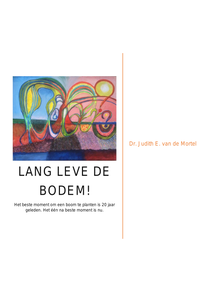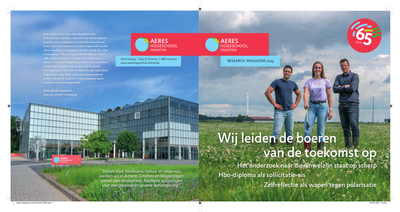Deze presentatie is ontwikkeld op verzoek van Delphy voor een workshop tijdens de landelijke informatiebijeenkomst pioenroos. In deze presentatie schets ik op basis van literatuuronderzoek een beeld van de problemen met Phytophthora cactorum in de pioenrozenteelt. Na een kort historisch overzicht worden de kenmerken en omstandigheden van deze oömyceet toegelicht. Vervolgens worden de levenswijze en de symptomen toegelicht en de mogelijkheid om zede ziekten met andere problemen te verwarren. Aan het eind van de presentatie verken ik de mogelijkheden om via een weerbaar teeltsysteem de problemen emt Phytophthora te verminderen.
MULTIFILE

Phytophthora infestans, the causal agent of late blight, remains the main threat to potato production worldwide. Screening of 19 accessions of Solanum dulcamara with P. infestans isolate Ipo82001 in detached leaf assays revealed strong resistance in an individual belonging to accession A54750069-1. This plant was crossed with a susceptible genotype, and an F(1) population consisting of 63 individuals was obtained. This population segregated for resistance in 1:1 ratio, both in detached leaf assays and in an open-field experiment. Presence of the formerly mapped Rpi-dlc1 gene as the cause of the observed segregating resistance could be excluded. Subsequently, AFLP analyses using 128 primer combinations enabled identification of five markers linked to a novel resistance gene named Rpi-dlc2. AFLP markers did not show sequence similarity to the tomato and potato genomes, hampering comparative genetic positioning of the gene. For this reason we used next-generation mapping (NGM), an approach that exploits direct sequencing of DNA (in our case: cDNA) pools from bulked segregants to calculate the genetic distance between SNPs and the locus of interest. Plotting of these genetic distances on the tomato and potato genetic map and subsequent PCR-based marker analysis positioned the gene on chromosome 10, in a region overlapping with the Rpi-ber/ber1 and -ber2 loci from S. berthaultii. Pyramiding of Rpi-dlc2 and Rpi-dlc1 significantly increased resistance to P. infestans, compared with individuals containing only one of the genes, showing the usefulness of this strategy to enhance resistance against Phytophthora.
DOCUMENT
In dit rapport worden de activiteiten van Wageningen Plant Research in het project ‘Databoeren met boerendata in de aardappelsector’, een POP3 project, beschreven. WPR heeft de applicatie NDICEA in het bedrijfsmanagementsysteem FarmMaps doorontwikkeld. Trefwoorden: digitalisering boerenbedrijf, pop3, databoeren, NDICEA, FarmMapsRVO zaaknummer: 17717000042
DOCUMENT

In dit rapport worden de activiteiten van Wageningen Plant Research in het project ‘Databoeren met boerendata in de aardappelsector’, een POP3 project, beschreven. WPR heeft de applicatie NDICEA in het bedrijfsmanagementsysteem FarmMaps doorontwikkeld. Trefwoorden: digitalisering boerenbedrijf, pop3, databoeren, NDICEA, FarmMapsRVO zaaknummer: 17717000042
DOCUMENT

Within the framework of Agrobiokon an internet application was developed allowing potatogrowers a simple evaluation of their potato late blight control strategy. The goal of developing this application was to confront the perception of growers regarding the protection level of their crops with an independent calculation of this level. Calculations ofthe daily infection risk allow growers to retrospectively track periods of under- and over protection of their crops. This form of interactive knowledge transfer is hoped to trigger improvements in growers’ potato late blight control strategies with respect to spray timing and fungicide selection.
LINK
Het Nieuwe Telen (HNT) heeft in haar theoretisch kader de teeltprocessen ingedeeld in zes balansen. De energiebalans, de waterbalans en de assimilatenbalans van de plant en de CO2 balans, de vochtbalans en de energiebalans van de kas. In dit project is onderzocht of de mineralenbalans, de ecologische balans en de hormoonbalans nuttige aanvullingen zijn op de bestaande balansen van HNT. Aanbevelingen: faciliteer onderzoek naar metingen die het mogelijk maken de status van de plant te volgen m.b.t. de mineralenbalans en ecologische balans.
DOCUMENT

Zonder data is het lastig om te discussiëren; welke voedselproductiemethode is nou beter voor het milieu en welke methode is toekomstgericht? In dit rapport wordt een opzet gedaan om deze data te kunnen verstrekken door een vergelijking te trekken tussen de voedselproductie via gangbare gewassen en de voedselproductie via voedselbossen. Gekeken wordt naar het effect op het natuurlijk kapitaal.
DOCUMENT

Inaugurele rede uitgesproken op 9 mei 2019 door Dr. J.E. (Judith) van de Mortel bij de benoeming tot lector “Gezonde plant op een vitale en duurzame bodem” aan HAS Hogeschool Venlo. De krant werd uitgegeven ter ere van de inaugurele rede. Dit deed ze op een bijzondere manier: alle genodigden gingen met een denkbeeldige tijdmachine vooruit naar het jaar 2030 waar ze Judith ontmoetten. Judith keek vervolgens terug naar het jaar 2019 en stelde dat ze hoopt dat de sector in de tussenliggende jaren bereikt heeft dat alle agrarische bodems in Nederland duurzaam beheerd worden door verschillende aanpakken te combineren. Om dit te illustreren schetste ze een beeld van hoe de agrarische onderneming er in 2030 uitziet. Met het lectoraat wil ze hieraan bijdragen. De krant is dan ook geschreven alsof het 9 mei 2030 is.
MULTIFILE

65 jaar Groen hoger onderwijs, gestart in Ede en al decennia in Dronten. Een prachtige mijlpaal! Het thema van deze uitgave veerkracht past uitstekend bij deze faculteit in Dronten. Met haar portfolio praktijkgerichte opleidingen waar ondernemen en primaire productie centraal staan onderscheidt zij zich van andere groene hbo’s. Het praktijk- en beroepsgerichte karakter van de faculteit zorgt ervoor dat bedrijven uit deagrifoodbusiness graag willen samenwerken. Voor de studenten een prachtige meerwaarde: zij maken tijdens hun studie de ontwikkelingen en innovaties van dichtbij mee. Ook de bedrijven biedt het voordeel, zij komen immers in contact met de nieuwe lichting jonge ondernemers of nieuwe medewerkers. Een win-winsituatie.
DOCUMENT
